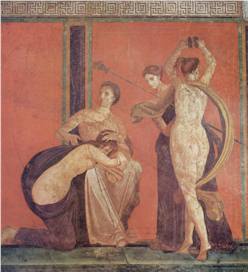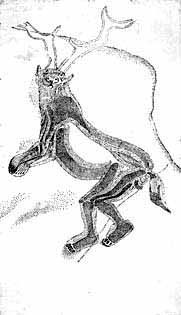| Introduction |
 |
 This second edition of the ARAS Online Newsletter features two articles and a helpful hint on using your computer to visit the site. The two apparently unrelated articles feature two aspects of ARAS Online and are linked by the Greek word dromenon, which signifies a ritual action or a "thing done." Mary Jo Spencer's classic paper, Amplification: The Dance, illustrates the basic ARAS principle of amplification. This is a process of circling around the meaning of a symbolic image — in this case "The Dance"— by seeing how it has appeared in many different places and times throughout human history. This process of "walking around" an image allows it to gain layers of meaning. Mary Jo Spencer places "the Dance" in the context of sacred ritual activity, of dromenon. The second article also describes a kind of dromenon or "thing done" — in this case the creation of ARAS Online itself. Archetypes can express themselves in images and in actions — even everyday actions in the contemporary world. We don't automatically think of a group working together to create a design, a pattern, a project as being archetypal — but if it is undertaken with a spirit of "sacred work", it can be as archetypal in its patterning and meaning as a cave drawing from 30,000 years ago. Creating ARAS Online was undertaken with this spirit and, as a "thing done," constructing ARAS Online by a dedicated group followed an archetypal pattern of creating meaning in the world and itself became a ritual Dance. This second edition of the ARAS Online Newsletter features two articles and a helpful hint on using your computer to visit the site. The two apparently unrelated articles feature two aspects of ARAS Online and are linked by the Greek word dromenon, which signifies a ritual action or a "thing done." Mary Jo Spencer's classic paper, Amplification: The Dance, illustrates the basic ARAS principle of amplification. This is a process of circling around the meaning of a symbolic image — in this case "The Dance"— by seeing how it has appeared in many different places and times throughout human history. This process of "walking around" an image allows it to gain layers of meaning. Mary Jo Spencer places "the Dance" in the context of sacred ritual activity, of dromenon. The second article also describes a kind of dromenon or "thing done" — in this case the creation of ARAS Online itself. Archetypes can express themselves in images and in actions — even everyday actions in the contemporary world. We don't automatically think of a group working together to create a design, a pattern, a project as being archetypal — but if it is undertaken with a spirit of "sacred work", it can be as archetypal in its patterning and meaning as a cave drawing from 30,000 years ago. Creating ARAS Online was undertaken with this spirit and, as a "thing done," constructing ARAS Online by a dedicated group followed an archetypal pattern of creating meaning in the world and itself became a ritual Dance.
Tom Singer, M.D.
Co-Chair of the ARAS Online Committee |
 
A Brief History of the Creation of ARAS Online |
 |
By Tom Singer, M.D., Co-chair of the ARAS Online Committee
 REVELATION REVELATION
I remember a moment of revelation when I was standing in front of the cereal section at the local grocery store and suddenly realized that all the boxes in front of me didn't just spontaneously generate themselves on the shelf—that they actually came from somewhere else where the cereal was created, put in a box, shipped and then placed on the shelf. In that moment, I became aware of my previous belief that Cheerios had always been there in the past and would always be there in the future, instantaneously regenerating themselves—just like the archetypes. For those of you who might share this kind of magical thinking about such things and may now believe that ARAS Online has always existed in the ether of cyberspace where it spontaneously generated itself and would be naturally occurring forever, I would like to tell you that this is not the case. Already, perhaps, some of us may take it for granted that ARAS Online has always been there, but this is far from the truth and I would like to give you some history of how it actually appeared on the shelf of the vast resources now available on the Internet.
Click here to view the rest of this article |
Send Us Your Questions |
 |
| If you have questions about specific images, searching, how to use ARAS, or archetypal symbolism in general, please email them to us at info@aras.org. |
|
 |
| Amplification: The Dance |
 |
By Mary Jo Spencer, ARAS San Francisco. This classic article originally appeared in Journal of Analytical Psychology 1984, Vol. 29, Pages 113-123 and is reproduced with permission.

THE THEME of dance has been a major and continuing motif throughout the analysis of a woman now in her seventies. The image of dance when it turned up often seemed to signal a point at which a major shift in attitude was being prepared for in the psyche itself. When I recognised this I became interested in the image of dance as an archetype since it related closely to material of my own. My patient gradually became interested in the process of amplification and what it added to her understanding as she went more deeply into her own material and began to know more about the process of psychological development. At a certain point she began to use ARAS for herself. There is no time in human history when dance has not existed, and no place in all the world where human beings have not danced. It is an activity in which psyche and soma are both involved, and to dance is to be immediately and totally present, as well as to be related timelessly to our remotest ancestors who also danced.
I have chosen three of my patient's dreams to illustrate the use of amplification in clinical work. Two are quite early in her work; the third is fairly recent.
1. I am dancing 'on point' before a small and appreciative audience at a social gathering. I am surprised and pleased to find myself doing so. Then I realise there is something behind me. I turn and look to see that a very tall man who is my partner has been carrying me. I have not really been dancing at all. The real credit goes to him. I feel both sad and embarrassed, for the audience knew he was there all along even though I did not.
2. I am dancing in the chorus of a classical ballet. I am excited and pleased but I also wonder if I shall ever be a 'real' dancer, i.e. dance a solo.
3. I see a figure dancing in the midst of a ruined sanctuary, perhaps something like a very early church, domed and small.
It was an arresting figure which danced there. The top portion to the waist was that of a dark-eyed, dark-haired woman dressed all in white, looking rather like the early monumental Greek women of Picasso, while the lower limbs and feet of the figure were hairy goat legs and hooves.
The figure was divided at the waist. It was 'not split' (she explained with care) but rather as if there were something like a membrane between the upper and lower half of the body. The figure was dancing, and my patient said she was moved for days afterward by the rhythmic beat of the capering goat hooves. It was nearly impossible for her to keep from dancing wherever she was when she remembered and heard the sound.
It was a wedding ceremony, the goat woman was the bride. Finally the groom arrived; but he was veiled. No one could see who or what he was.
The qualitative differences in the two early dreams and the later one are obvious. The earlier dreams, while suggesting creativity, have a narcissistic flavour and centre on 'performance', a useful thing in itself, but quite in contrast to the sense of depth, of paradox, and of transcendence in the third dream. Clearly the first images are personal, and the last is symbolic. All have 'meaning'; but the later dream has 'import' in the sense that Prochaska quotes Langer's use of that word.
The history of dance becomes relevant as we view the differences between the earlier and later dreams. A few slides from ARAS, which I shall describe, illustrate this fact.
 Les Trois Frères Les Trois Frères cave painting - 1Cc.129b |
|
First there is the Magdalenian image from Les Trois Frères cave of the 'so-called sorcerer; a masked male with round staring eyes, stag ears and antlers, beard falling on chest, hands held close together, fingers outstretched, body leaning forward covered with an animal pelt, human legs and feet in dancing position, erect phallus pointing backward below horse tail' (1Cc.129b).
Click here to view the rest of this article |
|
ARAS Hint: How to Forget Your Password |
 |
That's right. You don't need to remember your ARAS Online password because your computer will do so for you. When you log in at ARAS Online, look for the checkbox that says "Remember password on this computer." Just check it before you log in and your computer will remember your password from then on. When you log in again, your computer will fill your password in automatically for you.
Sometimes people clear off their browser's cookies, which are the small files that contain remembered facts like passwords. If you've recently cleared your cookies and thus your computer no longer has your password, just click on "Forgot password" on the login page and your password will be emailed to you in seconds.
With these two methods, you need never remember your ARAS Online password. So we urge you to simply "forget it." |
|

